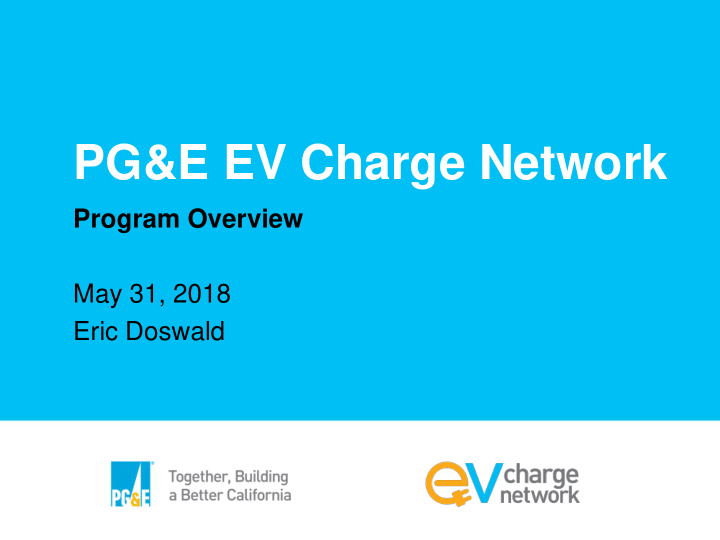



PG&E EV Charge Network Program Overview May 31, 2018 Eric Doswald
Program Summary Summary of Approved Decision: • Scope: 3 years (2018-2020); $130M budget • Scale: Up to 7,500 level 2 chargers (approx. 500-750 sites) • Sites: Multi-unit dwellings (MUDs) and workplaces • Ownership: PG&E can own up to 35% of the chargers, at MUDs and in disadvantaged communities (DACs) • Targets: 20% at MUDs and 15% in DACs Current Status: • Website: www.pge.com/evcharge • Online Application: now available on website
Key Features PG&E will pay for, maintain and coordinate construction of In addition to the infrastructure, a infrastructure from the pole to the portion of the charging equipment parking space (often 60-80% of the cost will be paid for by PG&E total project cost) Program participants can bill drivers Program participants have the or offer charging for free , and can option to own the chargers or have define access to the chargers, PG&E own the chargers* making them available to employees, fleet vehicles or the public Program participants can choose Program requires a minimum of 10 their charging equipment from an EV parking spaces per site approved vendor list * PG&E ownership is available for MUDs and customer sites located in disadvantaged communities
Customer Journey
Ownership Options EV Charge Owner EV Charge Sponsor Program participant owns PG&E owns chargers chargers * * PG&E ownership is available for MUDs and customer sites located in disadvantaged communities
Participant Costs Total costs will vary based on ownership model, customer segment, and charging equipment selected: EV Charge Owner EV Charge Sponsor (customer owns chargers) (PG&E owns chargers) Infrastructure No cost to program participant No cost to program participant costs Program participant submits a one- Program participant pays for Charging time participation payment to hardware; receives rebate based on equipment costs PG&E based on customer segment customer segment and hardware Responsibility of program participant No cost to program participant Installation costs Ongoing costs (maintenance; Responsibility of program participant No cost to program participant network fees) Offers more charger options and greater control of maintenance and Offers lower overall costs Key benefits operations
Rebate & Participation Payment Amounts EV Charge Owner Rebate Disadvantaged community Other PG&E areas Multi-unit $2,300 per port* $1,150 per port* dwelling $1,150 per port* $575 per port* Workplace EV Charge Sponsor Participation Payment Disadvantaged community Other PG&E areas Cost of chargers selected, Cost of chargers selected, Multi-unit less $2,300 per port* less $1,150 per port* dwelling N/A – this segment is not eligible for Cost of chargers selected, Workplace less $1,150 per port* this ownership option * 1 port = 1 parking space
Recovering Electricity Costs Program participants pay for electric service to the EV charging stations, but can select from two ways of recovering these costs from EV drivers: Pass Through Pricing Custom Pricing Program participant pays Time-of-Use (TOU) rate, using a dedicated Rates meter that serves only the EV chargers Program participant creates their Program participant passes the Pricing for EV own pricing structure, such as free drivers TOU rate directly to drivers charging or flat-rate charging Program participant communicates Program participant communicates the pricing structure to their Pricing implementation the pricing structure to their vendor vendor, and submits a load management plan to PG&E
Thank you Eric Doswald emdf@pge.com www.pge.com/evcharge READ AND DELETE For best results with this template, use PowerPoint 2003
Recommend
More recommend